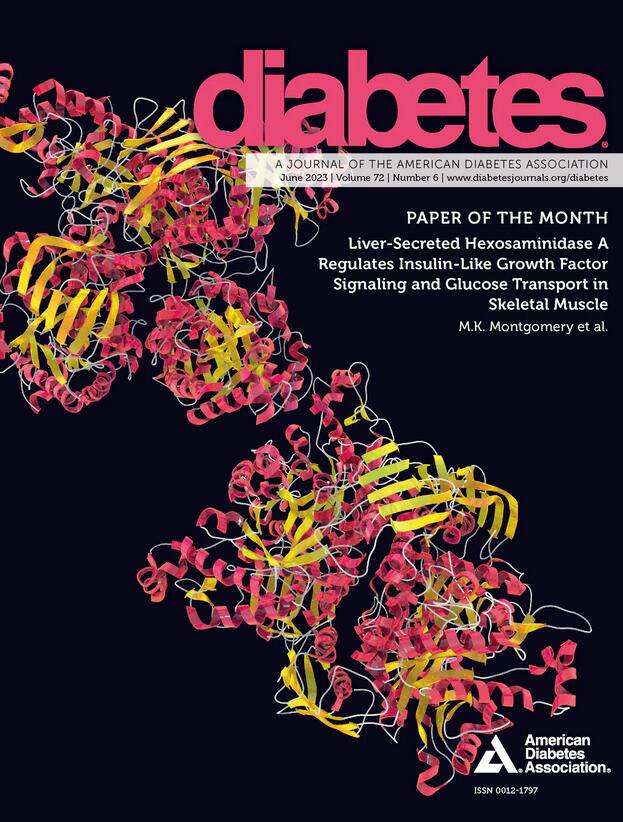863-P:一项多中心、随机、开放标签、对照研究,评估2型糖尿病患者从每日DPP-4抑制剂转向cofroglitin的有效性和安全性
IF 7.5
1区 医学
Q1 ENDOCRINOLOGY & METABOLISM
引用次数: 0
摘要
简介与目的:cofroglitin是一种新型的超长效DPP-4抑制剂(DPP-4i),在2型糖尿病(T2D)患者中维持良好的血糖控制,剂量为10mg,每两周一次。本研究旨在评估中国T2D患者将每日DPP-4i改为cofroglitin的有效性和安全性,重点关注血糖波动。方法:纳入先前每日DPP-4i联合或不联合二甲双胍治疗至少12周的T2D患者。符合条件的患者被随机1:1分配到每日DPP-4i组(继续用药)或cofrogliptin组(将每日DPP-4i改为双周cofrogliptin)治疗24周。第2周至第0周和第22周至第24周分别进行14天CGM。主要终点是从基线到24周的时间变化范围(TIR, 3.9-10.0 mmol/L)。结果:共纳入64名参与者,平均HbA1c为7.04%,TIR为83.79%。治疗24周后,cofroglitin组相对于基线的平均TIR(%)增加0.545,每日DPP-4i组减少9.614。两组间差异有统计学意义,最小二乘(LS)均值差为10.159 (95%CI: 3.194, 17.124, P=0.0050)。与基线相比,平均葡萄糖(MG, mmol/L)和变异系数(CV, %)的变化也有显著性差异,LS的平均差异为-1.016 (95%CI: -1.644, -0.388, P=0.0020)和-3.370 (95%CI: -5.998, -0.741, P=0.0129)。两组均未发生严重低血糖事件,不良事件发生率相似。结论:不论是否合用二甲双胍,从每日DPP-4i改为cofroglitin治疗可使T2D患者的TIR、MG和CV维持得更好,并表现出良好的耐受性和安全性。临床试验信息:NCT06703268。潘:没有。陈黎:没有。蒋:没有。冯:没有。王:没有。张:没有。王:没有。周鸿祎:没有。本文章由计算机程序翻译,如有差异,请以英文原文为准。
863-P: A Multicenter, Randomized, Open-Label, Controlled Study on Evaluating the Efficacy and Safety of Switching from Daily DPP-4 Inhibitors to Cofrogliptin in Patients with Type 2 Diabetes Mellitus in China
Introduction and Objective: Cofrogliptin is a novel ultra-long-acting DPP-4 inhibitor (DPP-4i) which could maintain good glycemic control in type 2 diabetes (T2D) patients with 10mg dose once biweekly. This study aims to assess the efficacy and safety of switching daily DPP-4i to cofrogliptin in Chinese T2D patients, focusing on blood glucose fluctuations. Methods: T2D patients previously treated by daily DPP-4i with or without metformin for at least 12 weeks were included. Eligible patients were randomly 1:1 assigned to the daily DPP-4i group (continued their medication) or the cofrogliptin group (switched the daily DPP-4i to biweekly cofrogliptin) for the treatment of 24 weeks. 14-day CGM was conducted from week -2 to 0 and from week 22 to 24. The primary endpoint was the change in time in range (TIR, 3.9-10.0 mmol/L) from baseline to 24 weeks. Results: A total of 64 participants with mean HbA1c of 7.04% and TIR of 83.79% were enrolled. After 24-week treatment, the mean TIR (%) relative to baseline changed by an increase of 0.545 in the cofrogliptin group and a decrease of 9.614 in the daily DPP-4i group. There was a significant difference between the two groups with least-squares (LS) mean difference of 10.159 (95%CI: 3.194, 17.124, P=0.0050). The change in mean glucose (MG, mmol/L) and coefficient of variation (CV, %) from baseline also showed significant difference with LS Mean difference of -1.016 (95%CI: -1.644, -0.388, P=0.0020) and -3.370 (95%CI: -5.998, -0.741, P=0.0129) in favor of the cofrogliptin group. There were no severe hypoglycemia events in both groups and the incidence of adverse events was similar between the two groups. Conclusion: The treatment of switching to cofrogliptin from daily DPP-4i resulted in better maintenance of TIR, MG, and CV in T2D patients, irrespective of metformin co-use, and showed good tolerability and safety. Clinical trial information: NCT06703268. Disclosure C. Pan: None. L. Chen: None. H. Jiang: None. Y. Feng: None. S. Wang: None. J. Zhang: None. Z. Wang: None. Y. Zhou: None.
求助全文
通过发布文献求助,成功后即可免费获取论文全文。
去求助
来源期刊

Diabetes
医学-内分泌学与代谢
CiteScore
12.50
自引率
2.60%
发文量
1968
审稿时长
1 months
期刊介绍:
Diabetes is a scientific journal that publishes original research exploring the physiological and pathophysiological aspects of diabetes mellitus. We encourage submissions of manuscripts pertaining to laboratory, animal, or human research, covering a wide range of topics. Our primary focus is on investigative reports investigating various aspects such as the development and progression of diabetes, along with its associated complications. We also welcome studies delving into normal and pathological pancreatic islet function and intermediary metabolism, as well as exploring the mechanisms of drug and hormone action from a pharmacological perspective. Additionally, we encourage submissions that delve into the biochemical and molecular aspects of both normal and abnormal biological processes.
However, it is important to note that we do not publish studies relating to diabetes education or the application of accepted therapeutic and diagnostic approaches to patients with diabetes mellitus. Our aim is to provide a platform for research that contributes to advancing our understanding of the underlying mechanisms and processes of diabetes.
 求助内容:
求助内容: 应助结果提醒方式:
应助结果提醒方式:


